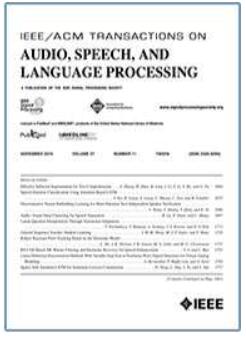使用注意递归网络的低延迟有源噪声控制。
IF 5.1
2区 计算机科学
Q1 ACOUSTICS
IEEE/ACM Transactions on Audio, Speech, and Language Processing
Pub Date : 2023-02-13
DOI:10.1109/TASLP.2023.3244528
引用次数: 3
摘要
由于有源噪声控制系统的因果关系约束,处理延迟是有源噪声控制的一个关键问题。本文在深度学习(即深度ANC)的背景下讨论了低延迟ANC。采用了一种使用注意递归网络(ARN)的时域方法来执行具有较小帧大小的深度ANC,从而减少了深度ANC的算法延迟。此外,我们引入了一种延迟补偿训练,以使用预测噪声执行ANC几毫秒。此外,在信号重新合成期间使用了修正的重叠相加方法,以避免由于相邻时间帧之间的重叠而引入的延迟。实验结果表明了所提出的策略在实现低延迟深度ANC方面的有效性。结合所提出的策略能够在不太影响ANC性能的情况下产生零甚至负的算法延迟,从而缓解ANC设计中的因果关系约束。本文章由计算机程序翻译,如有差异,请以英文原文为准。
Low-Latency Active Noise Control Using Attentive Recurrent Network
Processing latency is a critical issue for active noise control (ANC) due to the causality constraint of ANC systems. This paper addresses low-latency ANC in the context of deep learning (i.e. deep ANC). A time-domain method using an attentive recurrent network (ARN) is employed to perform deep ANC with smaller frame sizes, thus reducing algorithmic latency of deep ANC. In addition, we introduce a delay-compensated training to perform ANC using predicted noise for several milliseconds. Moreover, a revised overlap-add method is utilized during signal resynthesis to avoid the latency introduced due to overlaps between neighboring time frames. Experimental results show the effectiveness of the proposed strategies for achieving low-latency deep ANC. Combining the proposed strategies is capable of yielding zero, even negative, algorithmic latency without affecting ANC performance much, thus alleviating the causality constraint in ANC design.
求助全文
通过发布文献求助,成功后即可免费获取论文全文。
去求助
来源期刊

IEEE/ACM Transactions on Audio, Speech, and Language Processing
ACOUSTICS-ENGINEERING, ELECTRICAL & ELECTRONIC
CiteScore
11.30
自引率
11.10%
发文量
217
期刊介绍:
The IEEE/ACM Transactions on Audio, Speech, and Language Processing covers audio, speech and language processing and the sciences that support them. In audio processing: transducers, room acoustics, active sound control, human audition, analysis/synthesis/coding of music, and consumer audio. In speech processing: areas such as speech analysis, synthesis, coding, speech and speaker recognition, speech production and perception, and speech enhancement. In language processing: speech and text analysis, understanding, generation, dialog management, translation, summarization, question answering and document indexing and retrieval, as well as general language modeling.
 求助内容:
求助内容: 应助结果提醒方式:
应助结果提醒方式:


